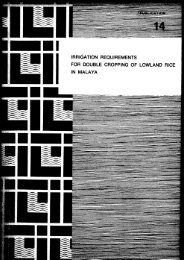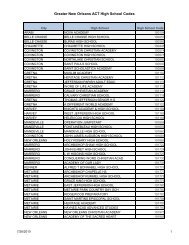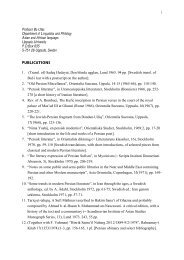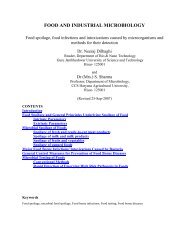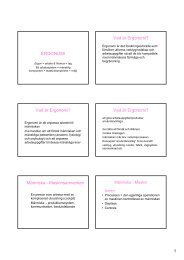On the Future of Indigenous Traditions - Munin
On the Future of Indigenous Traditions - Munin
On the Future of Indigenous Traditions - Munin
You also want an ePaper? Increase the reach of your titles
YUMPU automatically turns print PDFs into web optimized ePapers that Google loves.
Where does this divide <strong>of</strong> different positions <strong>of</strong> <strong>the</strong>se two sectors lead our discussion?<br />
To answer this question, <strong>the</strong> discussion is not limited to Adivasi and anti-Adivasi<br />
positions here. It is about two different perspectives and life orientations and <strong>the</strong><br />
values attached, i.e. <strong>the</strong> collective and communitarian vs. <strong>the</strong> individual and market<br />
oriented. In <strong>the</strong> context <strong>of</strong> modern nation-states, this distinction has been raised as <strong>the</strong><br />
basic survival question for <strong>the</strong> indigenous groups by <strong>the</strong>ir representatives in <strong>the</strong> last<br />
two decades at <strong>the</strong> United Nations through <strong>the</strong> introduction <strong>of</strong> <strong>the</strong> draft Declaration on<br />
<strong>the</strong> Rights <strong>of</strong> <strong>the</strong> <strong>Indigenous</strong> Peoples. However, <strong>the</strong> issues raised here are not denied<br />
by <strong>the</strong> state governments, but <strong>the</strong>re has been an on going debate on <strong>the</strong> definition <strong>of</strong><br />
‘indigenous’. In <strong>the</strong> United Nation Working Group’ process, it has also been argued at<br />
a point that <strong>the</strong> issue <strong>of</strong> indigenous people does not arise in Asian and African<br />
countries.<br />
The argument here is that <strong>the</strong> Adivasis are not accepted as Aboriginal on <strong>the</strong>ir land,<br />
but only as ‘Scheduled Tribe’. Moreover, <strong>the</strong> protective measures in <strong>the</strong>ir constitution,<br />
limits <strong>the</strong>ir own basis to have autonomous communities with <strong>the</strong>ir own social and<br />
cultural orientation. <strong>On</strong> <strong>the</strong> one hand <strong>the</strong> modern state treats <strong>the</strong>m as individuals on<br />
<strong>the</strong> same level as o<strong>the</strong>r citizens, yet on <strong>the</strong> o<strong>the</strong>r hand <strong>the</strong>re are conditions that arise<br />
which limit <strong>the</strong>m from letting <strong>the</strong>m ‘develop with <strong>the</strong>ir own genius’ – which has its<br />
basis in <strong>the</strong>ir social and cultural orientations. What causes this limitation is, when<br />
large scale developmental structures are introduced in <strong>the</strong>ir areas limiting Adivasis<br />
participation to <strong>the</strong> “reserved” seats. At <strong>the</strong> same time on <strong>the</strong> o<strong>the</strong>r hand, <strong>the</strong>re is a<br />
need among <strong>the</strong> Adivasis and indigenous peoples for wider consolidation <strong>of</strong> <strong>the</strong>ir<br />
perspectives.<br />
5.2. In search <strong>of</strong> modern benchmarks<br />
There could be a few broad areas <strong>of</strong> thoughts emerging out <strong>of</strong> <strong>the</strong> discussion on <strong>the</strong><br />
formation <strong>of</strong> this indigenous identity and <strong>the</strong> historical struggles for protecting itself<br />
and <strong>the</strong>ir distinctiveness. The argument brought forward from <strong>the</strong> earlier discussions,<br />
is to reiterate that <strong>the</strong> customary system <strong>of</strong> <strong>the</strong> Adivasis in Jharkhand is <strong>the</strong><br />
manifestation <strong>of</strong> <strong>the</strong>ir holistic identity. This identity is at threat <strong>of</strong> being<br />
overshadowed due to certain factors not questioned before. Thus, <strong>the</strong> question is how<br />
98





